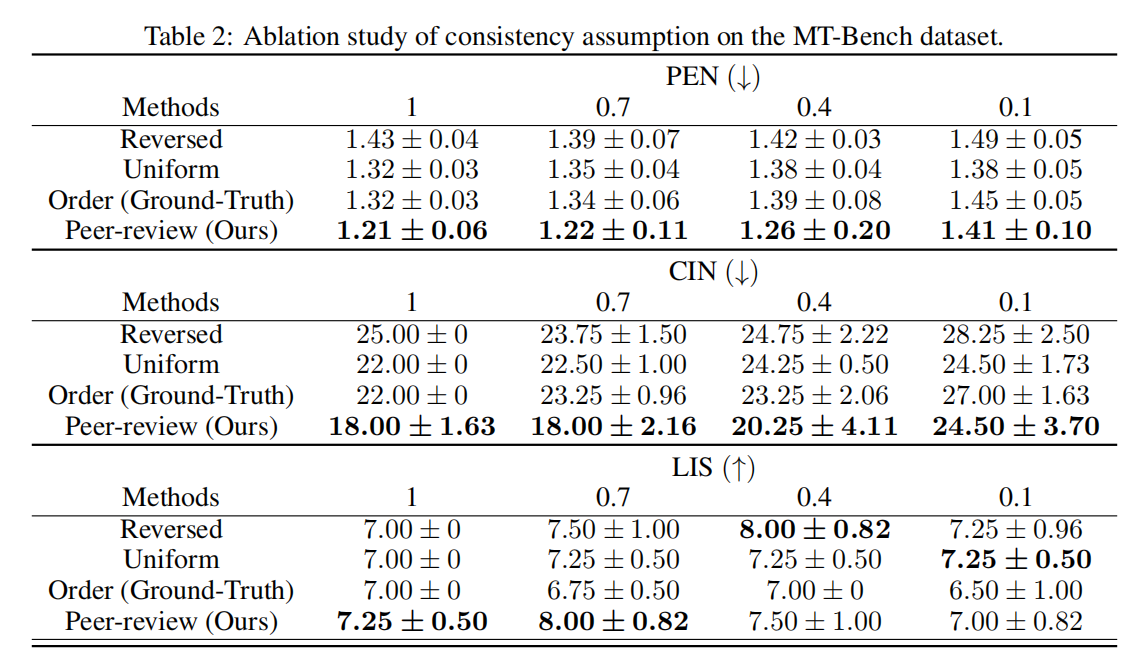Existing large language models (LLMs) evaluation methods typically focus on testing the performance on some closed-environment and domain-specific benchmarks with human annotations. We explore a novel unsupervised evaluation direction, utilizing peer-review mechanisms to measure LLMs automatically. In this setting, both open-source and closed-source LLMs lie in the same environment, capable of answering unlabeled questions and evaluating each other. To obtain the ability hierarchy among these models, we assign each LLM a learnable capability parameter to adjust the final ranking.We formalize it as a constrained optimization problem, intending to maximize the consistency of each LLM's capabilities and scores. The key assumption behind is that high-level LLM can evaluate others' answers more accurately than low-level ones, while higher-level LLM can also achieve higher response scores.
Peer-review-in-LLMs is a novel LLM automatic evaluation direction without human feedback, utilizing peer-review mechanisms to measure LLMs automatically. All LLMs can answer unlabeled questions and evaluate each other.
A constrained optimization based on the consistency assumption is proposed to re-rank the LLMs to be closer to human rankings.
- The key assumption is that high-level LLM can evaluate others’ answers more accurately (confidence) than low-level ones, while higher-level LLM can also achieve higher answer-ranking scores.
We propose three metrics called PEN (Permutation Entropy), CIN(Count Inversions), and LIS(Longest Increasing Subsequence) on the peer-review-in-LLMs framework for evaluating the gap with human preferences.
Our 'Peer-review-in-LLMs' framework integrates peer review with LLMs for response evaluation. It unfolds in two phases: first, LLMs generate and peer-review responses to questions, ranking them by confidence. Next, we refine these weights through consistency optimization, aiming to minimize the system's entropy, thereby achieving the final ranking
Our experimental results, derived from tests conducted on the Chatbot Arena, MT-Bench, and Alpaca-Farm datasets. Across all three datasets, our Peer Review method (Ours) outperformed the other three settings on all metrics, demonstrating its robustness and generalizability across different datasets.
- Chatbot Arena
- MT-Bench
- Alpaca-Farm
Clone this repo and install the requirements.
$ git clone https://github.com/PKU-YuanGroup/Peer-review-in-LLMs
$ cd Peer-review-in-LLMs
$ pip install --upgrade pip
$ pip install -r requirements.txtYou can directly use our complete dataset by downloading it from this link:
https://drive.google.com/drive/folders/1c2tDhaGiuwrtwja05EFVMZCweXey86sM?usp=sharing. After downloading, place the 'mt_bench' folder into the 'data' folder. Alternatively, you can simply run the Peer review code in its entirety.
After downloading the data, you can directly run main.py to experience the optimization process of Consistency Optimization using the review results from 15 models on the mt_bench dataset.
$ python main.pyThis code is executed within the 'llm_judge' folder.
$ cd Peer-review-in-LLMs/llm_judgeGenerate model responses
$ python gen_model_answer.py \
--model-path [/path/to/model] \
--model-id [MODEL-ID] \
--bench-name mt_bench If using proprietary models such as GPT-3.5 or GPT-4 as reviewers, you need to enter the key first.
$ export OPENAI_API_KEY=XXXXXX # set the OpenAI API key
$ python gen_model_answer.py \
--model-id [MODEL-ID] \
--bench-name mt_bench Arguments:
[MODEL-PATH]is the path to the weights, which can be a local folder or a Hugging Face repo ID.[MODEL-ID]is a name you give to the model.[BENCH-NAME]is the name the dataset you use
e.g.,
python gen_model_answer.py --model-path PKU-YuanGroup/vicuna-7b-v1.5 --model-id vicuna-7b-v1.5 --bench-name mt_bench
After retrieving all responses from the models to be evaluated, pair the responses and assign Reviewers.
$ python assign_judge.pyAfter assigning reviewers, review the battle pairs and output the judgment.
$ python gen_judgment.py \
--mode pairwise-all \
--new-judge-model [MODEL-ID] \
--model-list [LIST-OF-MODEL-ID]\
--batch-size [BATCH-SIZE] \
--bench-name mt_bench \
--judge-model-path [/path/to/model] If using proprietary models such as GPT-3.5 or GPT-4 as reviewers, you need to enter the key first.
$ export OPENAI_API_KEY=XXXXXX # set the OpenAI API key
$ python gen_judgment.py \
--mode pairwise-all \
--new-judge-model [MODEL-ID] \
--model-list [LIST-OF-MODEL-ID]\
--bench-name mt_bench Arguments:
[MODE]is the method of conducting reviews.[MODEL-ID]is a name you give to the model.[LIST-OF-MODEL-ID]is the list of models being reviewed.[BATCH-SIZE]is the batch size for processing at one time.[BENCH-NAME]is the name the dataset you use[JUDGE-MODEL-PATH]is the path to the weights. e.g.,
$ python gen_judgment.py \
--mode pairwise-all \
--new-judge-model vicuna-7b-v1.5 \
--model-list WizardLM-13B-V1.2 gpt4all-13b-snoozy oasst-sft-4-pythia-12b-epoch-3.5 vicuna-7b-v1.5 chatglm-6b guanaco-33b-merged stablelm-tuned-alpha-7b gpt-3.5-turbo koala-13b llama-13b fastchat-t5-3b-v1.0 dolly-v2-12b vicuna-13b-v1.5 alpaca-13b mpt-7b-chat \
--batch-size 512 \
--bench-name mt_bench \
--judge-model-path PKU-YuanGroup/vicuna-7b-v1.5
The code for the Consistency Optimization stage is executed within the 'Peer-review-in-LLMs/con_optimization' folder, and the results are saved in the 'log' folder.
$ python main_ablation.py \
--baseline [BASELINE] \
--mode [MODE] \
--epoch [EPOCH]
Arguments:
[BASELINE]determines whether to run the baseline. If set to 0, it runs Peer-review (Ours).[MODE]selects the baseline mode, with three options: Reversed, Uniform, and Order.[EPOCH]is the number of epochs for conducting Peer-review (Ours)
If you find our paper and code useful in your research, please consider giving a star ⭐ and citation 📝.
@misc{ning2024peerreviewinllms,
title={Peer-review-in-LLMs: Automatic Evaluation Method for LLMs in Open-environment},
author={Kun-Peng Ning and Shuo Yang and Yu-Yang Liu and Jia-Yu Yao and Zhen-Hui Liu and Yu Wang and Ming Pang and Li Yuan},
year={2024},
eprint={2402.01830},
archivePrefix={arXiv},
primaryClass={cs.CL}
}







